

Battle of Bannockburn. Coordinates: The Battle of Bannockburn (Blàr Allt a' Bhonnaich in Scottish Gaelic) (24 June 1314) was a significant Scottish victory in the Wars of Scottish Independence.

Battle of Bannockburn. Date - 23rd and 24th June 1314Combatants - King Robert the Bruce of Scotland .v.
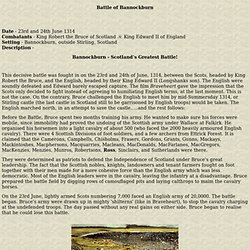
King Edward II of EnglandSetting - Bannockburn, outside Stirling, ScotlandDescription - Bannockburn - Scotland's Greatest Battle! The Battle of Bannockburn. On 23 and 24 June 1314, Robert the Bruce faced King Edward II at Bannockburn, near Stirling.

The Scots army was outnumbered almost three to one. Edward had more than 2000 battle-hardened knights to Bruce’s 500 horsemen. A mere 6000 Scots foot soldiers faced Edward’s force of 16,000 infantry. It was the first time since Falkirk that an English king had led his army in battle in Scotland. In 1298 Edward Longshanks had destroyed Wallace’s army. Bruce had lost almost everything. Robert the Bruce-2. The Battle of Bannockburn The new English King, the ineffectual Edward II, a pale shadow of his resolute father, responded belatedly by marching his forces into Scotland to meet Robert the Bruce.
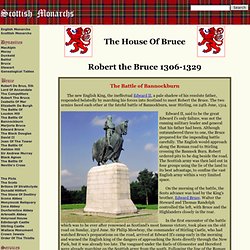
The two armies faced each other at the fateful battle of Bannockburn, near Stirling, on 24th June, 1314. Edward II, said to be the great Edward I's only failure, was not the cunning military leader and general that his father had been. The Battle Of Bannockburn 1314. And the English, headed by their King Edward II (Longshanks son).

The English were soundly defeated and Edward barely escaped capture. The film Braveheart gave the impression that the Scots only decided to fight instead of agreeing to humiliating English terms, at the last moment. This is not the case. On the contrary, Bruce won because he and his army of 5000 men, were better prepared for this battle than were the much larger English forces of 20,000.
Robert Bruce & The Battle of Bannockburn. Battle of Bannockburn - a summary. Robert the Bruce prepares The ground that Robert the Bruce (pictured) chose for the battle, which was to determine the fate of his country and crown, was that which would give him the best advantage against the superior forces he was likely to face.

He took up position just to the north of the Bannock Burn with the thickly wooded New Park giving cover to his rear. The English army, advancing from the south, would have to cross the burn in order to engage the Scots, but with areas of swamp on either flank they would be severely restricted in their movement. The Scots army was standing directly in the path of the English host, and their goal of saving the garrison at Stirling castle could only be achieved by a frontal assault against Bruce’s well-drilled spearmen. The Scots were drawn up in three infantry formations, or shiltrons, with a small contingent of cavalry. In all, the king had about 6-7,000 men in his army. Robert the Bruce & Battle of Bannockburn, pt.2. It was horrible to see and hear, said Barbour, seeing it and hearing it years later in the fireside tales of old men.
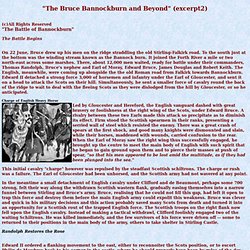
"For men of valour and of might did many deeds of courage. " Click on this link to see the battlefield map of Bannockburn ! Map of Bannockburn battlefield and troop positions. The Battle Becomes Hand to Hand Combat Close combat at Bannockburn Now on came the Scottish left wing, under Walter the Steward, and Sir James Douglas, so that the whole line was engaged in a desperate hand to hand conflict with the enemy. Bruce's spearmen advanced steadily, gradually pressing the English army into the marshy ground where they could not maneuver. With their knights already immersed in the melee, the Welsh and English archer had little opportunity to break the Scots with their arrow storm. Too late Edward tried to use the archers whose whispering arrows and long white bows had won Falkirk for his father.
Keith's Cavalry Called into Action. Heritage History presents English History Stories - I by Alfred J. Church. Historic Scotland Data Website - Battlefields: Battle of Bannockburn. Medieval - The Battle of Battle of Bannockburn. Battle of Bannockburn24th June 1314 Robert Bruce had been elected guardian of Scotland in 1298, replacing William Wallace as the leader of the long campaign against the English attempt to conquer Scotland.
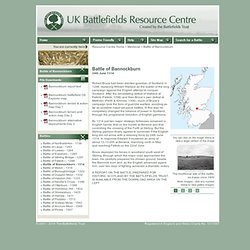
After the devastating defeat of Wallace at Falkirk (Falkirk, 1298) and then Bruce’s own defeat at Methven (Perth & Kinross, 1306), much of Bruce’s campaign took the form of guerrilla warfare, avoiding as far as possible major set piece battles. In this way he completely changed the balance of power in Scotland, through the progressive reduction of English garrisons. By 1314 just two major strategic fortresses remained in English hands: that on the border at Berwick and that controlling the crossing of the Forth at Stirling. But the Stirling garrison finally agreed to surrender if the English king did not arrive with a relieving force by 24th June 1314. Time capsule from 1930s found at Bannockburn flagstaff in Stirlingshire. 17 January 2013Last updated at 06:49 ET The flagstaff at the Bannockburn memorial is being repaired ahead of the 700th anniversary of the battle Conservationists repairing a flagpole at the Bannockburn memorial in Stirlingshire have found a time capsule from more than 75 years ago.
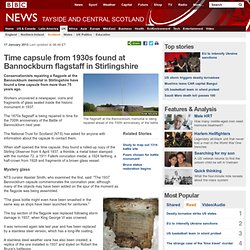
Workers uncovered a newspaper, coins and fragments of glass sealed inside the historic monument in 1937. The 1870s flagstaff is being repaired in time for the 700th anniversary of the Battle of Bannockburn next year. The National Trust for Scotland (NTS) has asked for anyone with information about the capsule to contact them. When staff opened the time capsule, they found a rolled-up copy of the Stirling Observer from 6 April 1937, a thimble, a metal token stamped with the number 72, a 1911 Falkirk coronation medal, a 1924 farthing, a half-crown from 1928 and fragments of a brown glass vessel. Mystery glass. Robert I 'The Bruce'